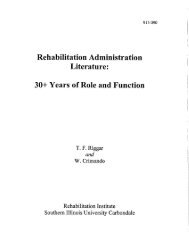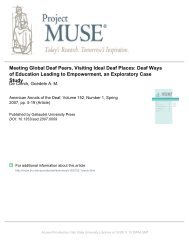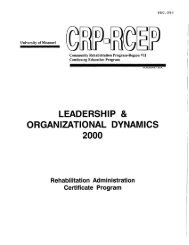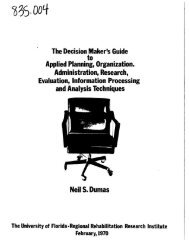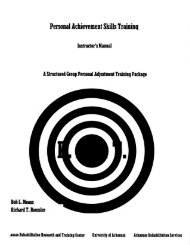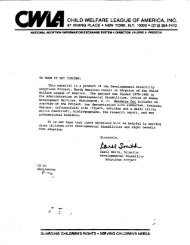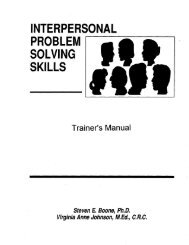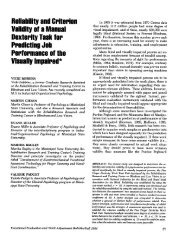by requirements for the degree of (Education) - NCRTM
by requirements for the degree of (Education) - NCRTM
by requirements for the degree of (Education) - NCRTM
Create successful ePaper yourself
Turn your PDF publications into a flip-book with our unique Google optimized e-Paper software.
who received on-campus 0JT. He s.u.ggests that <strong>the</strong> in-school work experience<br />
would be especially useful <strong>for</strong> those students with less ability who require<br />
closer supervision [Howe, 1967).<br />
]]e philosophy and operation <strong>of</strong> <strong>the</strong> work-study concept can be better<br />
understood <strong>by</strong> examining a few typical programs.<br />
The results <strong>of</strong> a 1968 Pocatello, Idaho demonstration project, in which<br />
16-year old mentally retarded students began work in <strong>the</strong> community while<br />
attending school, indicate that vocational rehabilitation and involvement<br />
in a work experience program during adolescence can lead to employability<br />
and independent functioning. Special education classes and special teaching<br />
techniques were used to prepare junior and senior high school EMR's <strong>for</strong><br />
employment. Work evaluation and employment experience were provided <strong>for</strong><br />
ninth grade students in <strong>the</strong> <strong>for</strong>m <strong>of</strong> on-campus training. This in-school.<br />
work experience was directed toward <strong>the</strong> development <strong>of</strong> good work habits,<br />
realistic self-evaluation, improved interpersonal relationships, self-<br />
confidence, and maturity. At <strong>the</strong> .age <strong>of</strong> 16, subjects were placed in jobs<br />
in <strong>the</strong> community and were employed from three to four hours a day. The<br />
school continued to provide supervision <strong>of</strong> each subject and gave <strong>the</strong> em-<br />
ployer an honest evaluation <strong>of</strong> each subject. Employers provided realistic<br />
work situations, job instruction, and evaluation, and .agreed to consult<br />
with <strong>the</strong> school on <strong>the</strong> job per<strong>for</strong>mance and problem areas <strong>of</strong> each subject.<br />
were paid a salary and this made <strong>the</strong>m enthusiastic about <strong>the</strong>ir<br />
Subjects<br />
and provided opportunities to teach <strong>the</strong>m to man.age money.. All students<br />
job<br />
placed in jobs proved to be capable <strong>of</strong> per<strong>for</strong>ming <strong>the</strong>m. Failures were due<br />
a lack <strong>of</strong> social acceptance or poor. groomi.ng.<br />
to<br />
and Bolanovitch (1966) reported on a work-study project at <strong>the</strong><br />
Bitter<br />
Work Experience Center in St. Louis, Missouri, which demonstrated that even.<br />
25




